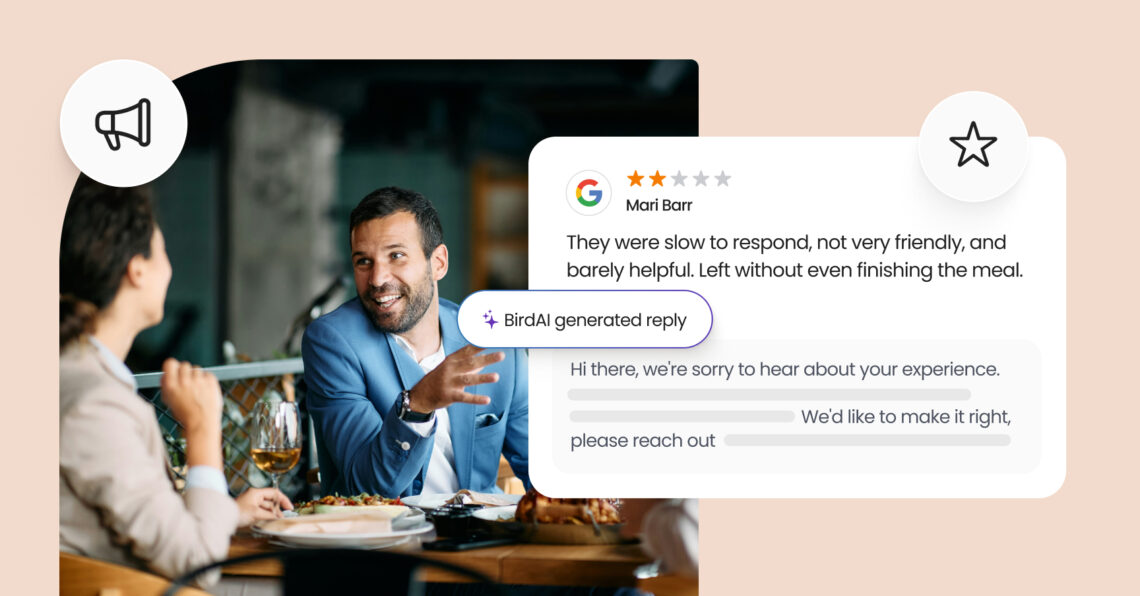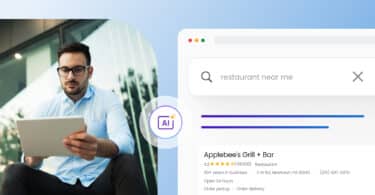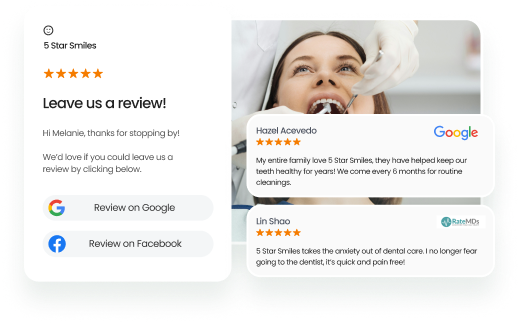Restaurant review monitoring isn’t just a task—it’s now a mission-critical strategy for restaurants that want to win trust, stay discoverable, and drive more bookings. When potential customers search for where to eat, they aren’t just looking at menus. They’re scanning star ratings, positive reviews, and what other diners have said about food quality, service, and cleanliness on restaurant review platforms.
But here’s the real difference between average restaurants and the ones diners line up for: The best brands don’t just read reviews—they respond quickly, detect patterns in customer feedback, and use those insights to fix broken experiences before they go viral.
This blog shows how the world’s most successful restaurants monitor and act on their online reviews across multiple sites.
Stop chasing stars—control the narrative
Stop chasing stars—control the narrative. The most successful restaurant chains don’t just track reviews; they treat them like live intelligence. In 2026, you can’t afford to guess how your guests feel. We’ll show you the proven systems top restaurant chains use to track user-generated reviews, ace their restaurant’s reputation management, exactly what tools they use, how they organize internal teams, so you can apply the same playbook in your business.
Table of contents
- How review monitoring became mission-critical for restaurant success
- 9 examples of top chains executing restaurants review monitoring
- How to build your own restaurant review monitoring system?
- What else influences restaurant reviews? Niche signals to watch
- How Birdeye helps restaurants master review monitoring
- FAQs on restaurant review monitoring
- Restaurant review monitoring with Birdeye drives trust, loyalty, and growth
What is restaurant review monitoring?
It’s the process of tracking, analyzing, and responding to restaurant reviews across platforms like Google, Yelp, and other review sites to improve the customer experience and protect your online reputation.
How review monitoring became mission-critical for restaurant success
In 2026, a restaurant’s reputation isn’t shaped by food alone—it’s defined by how well it manages online reviews. And the numbers speak for themselves: According to Birdeye’s 2025 State of Online Reviews report, total review volume grew by 13% in 2024. That means more diners are sharing feedback—and more potential guests are checking it before deciding where to eat.
With 81% of all reviews now appearing on Google, the stakes are even higher. One negative review or delayed response can sink a listing’s visibility on Google Maps or cause a dip in star ratings, costing you real revenue. That’s why restaurant owners aren’t just tracking reviews—they’re investing in structured review management systems that help them respond quickly, spot trends, and protect their restaurant’s online reputation.
And it’s not just about damage control. Reviews today are packed with valuable insights—from recurring complaints about food quality to compliments on an attentive server or allergy-friendly menu options. The best brands use this data to tighten operations, train staff, and deliver better dining experiences.
Here’s what’s driving this shift:
- Review requests are up 25% YoY, showing a surge in efforts to collect more reviews.
- 73% of businesses now respond to customer feedback—a 15% jump from the year before.
- Reviews with comments have risen to 81%, providing richer data for analyzing guest feedback.
So, restaurant review monitoring is no longer reactive—it’s proactive. It’s about understanding how customers perceive your business across all major review platforms, and using that feedback to stay ahead.
Now that we’ve established why monitoring matters, let’s get specific. What are the top restaurant brands actually doing behind the scenes to manage reviews at scale?
From online reputation management tools to team workflows, the next section reveals how ten standout chains have turned review management into a competitive advantage—and what your business can borrow from their playbooks.
9 examples of top chains executing restaurants review monitoring
If you want to understand how serious brands manage their restaurant reviews, look at how they’re structured. Top-performing restaurant chains treat restaurant review monitoring like a daily operational ritual—not just a restaurant marketing task. With review volume growing every year, these brands have built systems that allow them to:
- Track reviews across multiple sites like Google, Yelp, TripAdvisor, and Facebook
- Prioritize reviews by sentiment, location, or urgency
- Assign internal owners to resolve issues
- Identify recurring feedback themes and fix root causes
- Maintain a consistent online reputation at scale
Whether it’s a local manager replying to a guest or a corporate team analyzing trends, online reputation monitoring has become critical to retaining customers and maintaining trust. Here’s how nine top chains structure their review process:
1. Black Bear Diner — Make review monitoring scalable across 150+ locations
As Black Bear Diner expanded across 13 states, managing restaurant review monitoring at scale became a challenge. Each new location added more online reviews, platforms, and expectations for timely responses.
To support this growth, they turned to Birdeye. With its role-based dashboards, Birdeye gave diner-level managers, district leads, and regional VPs access to reviews tailored to their responsibilities. If a guest left a negative review, Birdeye automatically created a support ticket and routed it to the right manager. This system ensured that no issue went unnoticed—and every response was tracked.
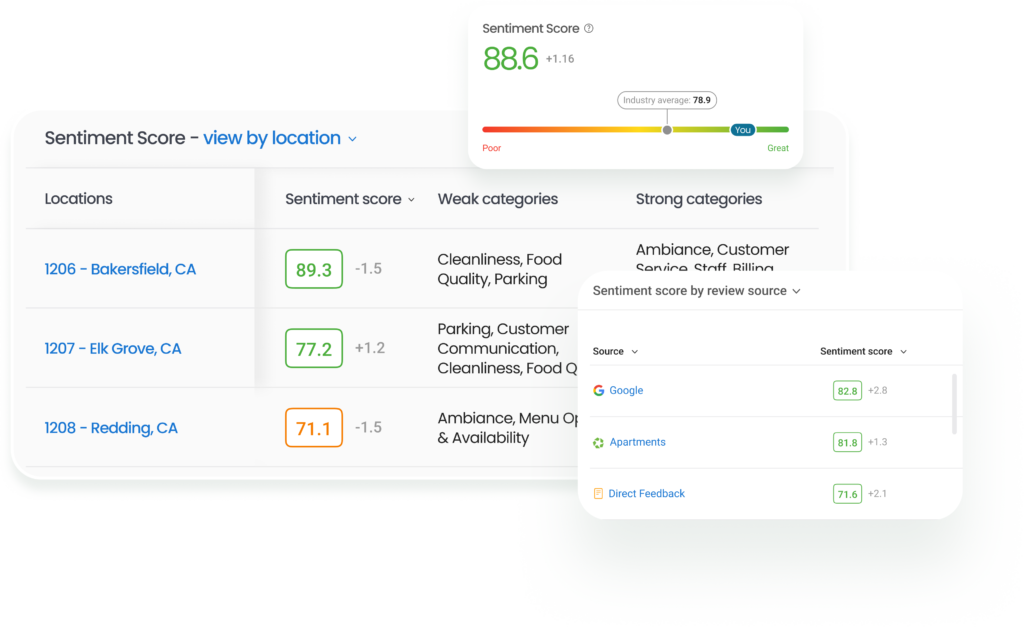
Custom dashboards also helped new managers onboard faster, while operations teams used Birdeye’s reporting features to monitor response times and review trends by territory. Even as review volume surged, Black Bear maintained a consistent 4-star rating and improved visibility across review platforms like Google Maps and Facebook.

2. The Saxton Group — Catch hidden business issues before they affect sales
With over 80 McAlister’s Deli locations, The Saxton Group needed a way to manage a rising volume of online reviews across locations and act on them fast. They adopted Birdeye to consolidate feedback, route issues, and spot trends through sentiment tracking.
One key insight came when negative reviews started pouring in about a $1 increase in kids’ meals. Even before sales data reflected a dip, Birdeye’s review monitoring dashboard surfaced the pattern. The team quickly reversed the pricing change—protecting revenue and customer loyalty.

They also improved response time by 308%, thanks to Birdeye’s automated ticketing and notifications. With a 97% review response rate, The Saxton Group now treats its hotel reviews as early-warning signals—not afterthoughts.
3. Cunningham Restaurant Group — Protect local SEO and review consistency at scale
Operating 40+ restaurants across three states, Cunningham Restaurant Group struggled to maintain accurate listings and consistent review management. With different platforms showing outdated business info, their restaurant’s online reputation was taking a hit.
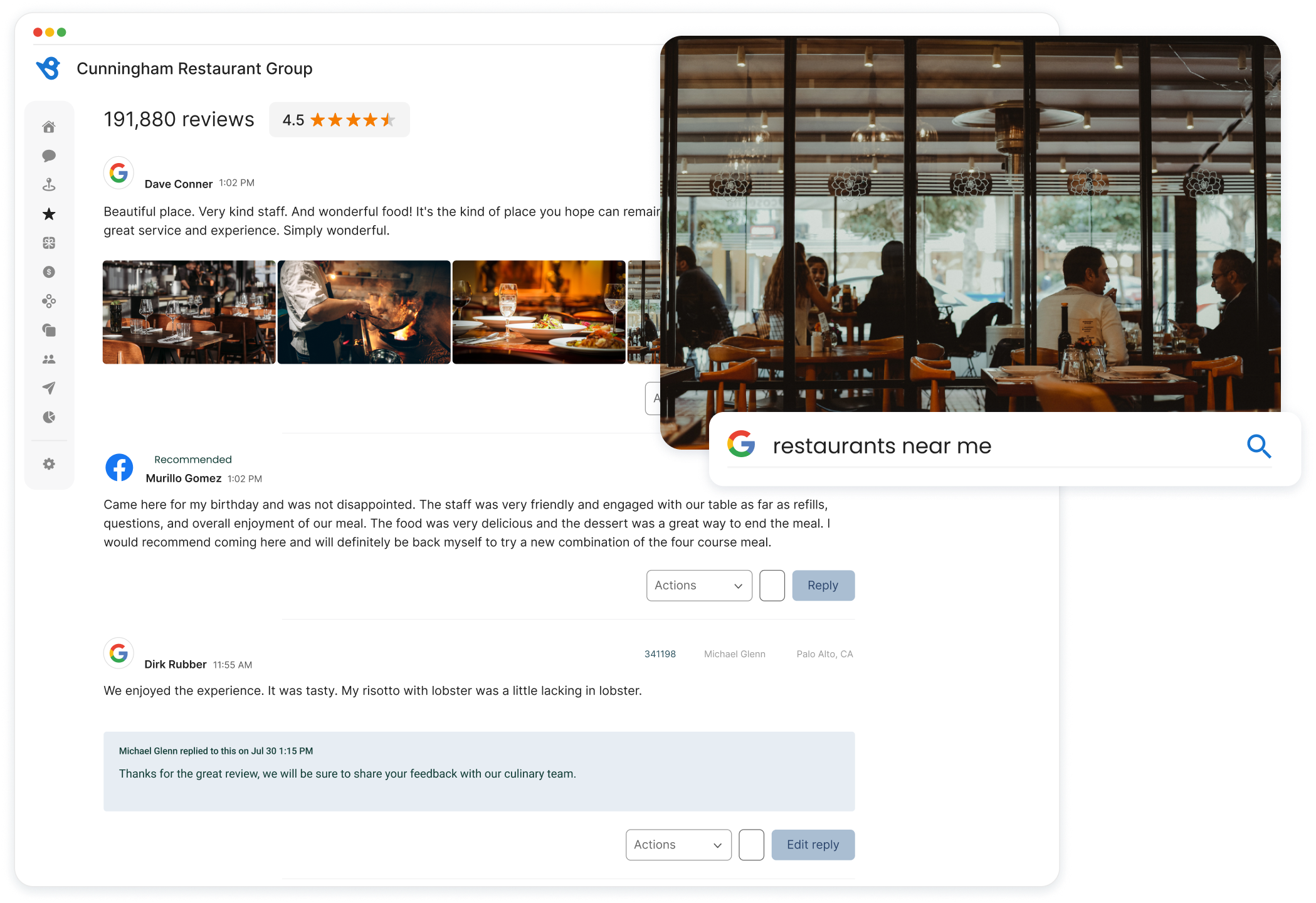
Birdeye Listings AI helped them sync accurate location data across restaurant review sites like Google, Facebook, and OpenTable—preventing lost traffic and confused customers. On the review monitoring side, Cunningham used Birdeye’s Reviews AI to scan user generated reviews, auto-tag sentiment, and assign templated responses that matched the brand voice.

This dual approach helped them respond faster, rank higher in local SEO, and turn customer feedback into operations-level insight. Their team can now quickly identify review themes—like slow service or unclear pickup instructions—and correct them before they escalate.
4. Fireman Hospitality Group — Automate review collection with daily feedback loops
Managing 13 high-traffic locations in NYC and Maryland, Fireman Hospitality Group needed a scalable way to collect and act on guest feedback. Their biggest challenge? Too much manual follow-up and missed review opportunities.
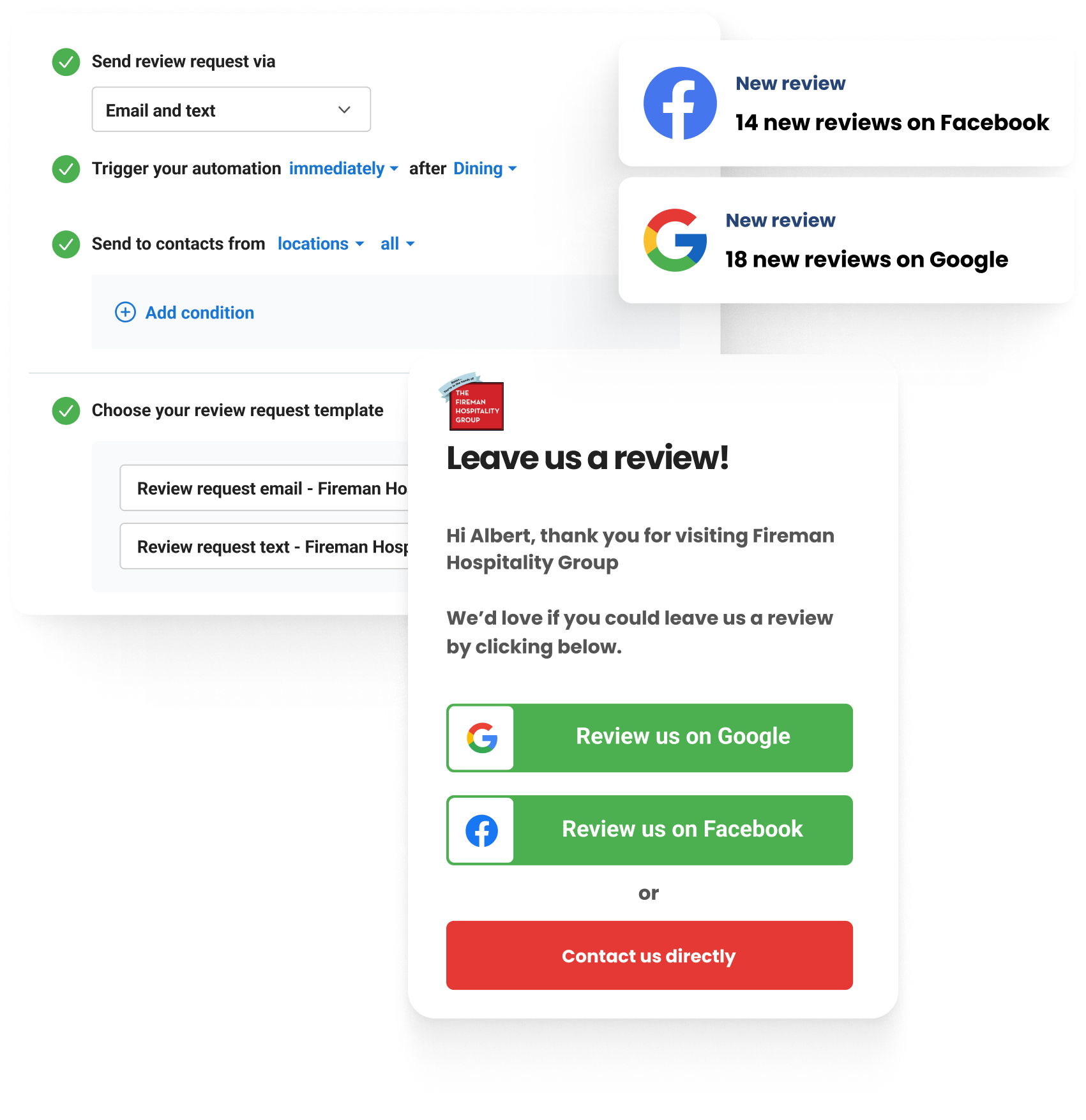
By connecting their Toast POS system with Birdeye, they now send review requests automatically after each visit. This integration has generated 8,400+ new reviews, increasing both review generation and volume.
Every morning, store managers receive a summary email from Birdeye with the latest reviews across platforms. These digests flag positive feedback for staff recognition and highlight unresolved issues for quick follow-up. With a 97% response rate and consistent star ratings, Fireman now closes the loop on guest experiences daily—without extra manual work.

5. Chick-fil-A — Empowering store-level review monitoring
Chick-fil-A emphasizes decentralized review management by entrusting individual store managers with the responsibility of monitoring and responding to online reviews. This approach ensures that feedback is addressed promptly and authentically, reflecting the brand’s commitment to customer service.
A notable instance highlighting the impact of online reviews involves former employee Miriam Webb, who gained significant attention on TikTok by sharing her staff meal experiences. Her content resonated with many, showcasing the influence of authentic customer (and employee) experiences on brand perception.
6. Domino’s — From review crisis to national brand recovery
Domino’s has a long-documented case of review-triggered transformation. In the late 2000s, poor online reviews and video scandals tanked its public image. Instead of ignoring the feedback, Domino’s featured real customer feedback in its “Pizza Turnaround” campaign—showing that it read, absorbed, and acted on the criticism.
Since then, Domino’s continues to track review sentiment as a brand health metric, actively responding to recurring themes and making operational tweaks (like delivery improvements or crust changes) based on feedback trends.
7. Shake Shack — Fast, transparent response loops on social and review platforms
Shake Shack emphasizes speed in both public reviews and social responses. Locations aim to respond to Google business reviews and Yelp reviews within 48 hours, but they’re also highly responsive to Instagram and Twitter mentions.
In several viral examples, the brand has offered refunds or personal outreach after a complaint was posted online—even when it wasn’t left as a formal review.
This fast-turnaround mentality helps them recover from negative reviews before they impact wider reputation.
8. Cracker Barrel — Navigating backlash over interior redesign
Recently, Cracker Barrel announced a $700 million brand overhaul, updating its menu and redesigning restaurant interiors to offer a brighter, more modern atmosphere. However, these changes sparked criticism from loyal customers who missed the traditional rustic Southern aesthetic.
Social media platforms saw a flurry of negative feedback, including a viral Reddit post lamenting the new design:
Cracker Barrel responded by acknowledging the emotional impact of the makeover and emphasizing that the brand’s core identity remained intact. This situation highlighted the importance of monitoring customer feedback and being prepared to address concerns transparently.
9. The Supper Truck — Turning a negative Review into a viral apology
In 2014, The Supper Truck, a food truck business, received a scathing one-star Yelp review criticizing long wait times and food quality. Instead of a standard apology, the owner commissioned a heartfelt song titled “One Star Review” to address the customer’s concerns.
The song humorously and sincerely apologized for the poor experience, offered an explanation, and even promised a complimentary meal. This creative response not only aimed to win back the dissatisfied customer but also served as a clever marketing tactic, garnering positive attention and showcasing the brand’s commitment to customer satisfaction.
If these big-brand tactics seem out of reach, don’t worry. You don’t need a nationwide footprint or a multimillion-dollar campaign to improve your restaurant’s review strategy.
In the next section, we’ll walk through how to build a practical, scalable review monitoring system—designed for single-location businesses, multi-unit operators, and everyone in between.
How to build your own restaurant review monitoring system?
You don’t need a national footprint to take control of your restaurant’s online reputation. Whether you run a single location or manage a growing restaurant business, setting up a system to track and act on restaurant reviews is the first step toward a stronger customer experience.
Here’s a simple, scalable framework any restaurant owner can use to monitor feedback, respond faster, and turn insights into impact.
Centralize reviews from every major site
Manually checking the top restaurant review site is time-consuming and error-prone. Use a dashboard or review aggregator to pull in feedback from online review sites like Google, Yelp, Facebook, and TripAdvisor. This lets you monitor all your reviews in one place—so nothing slips through.
Pro tip: Don’t forget about niche or local restaurant marketing sites like Yelp, OpenTable, or even Foursquare City Guide, which are popular among traveling diners and tourists.
Set alerts by keyword, sentiment, or location
Enable real-time notifications when a negative review is posted or when someone mentions high-stakes terms like “undercooked,” “rude,” or “food allergy.” Set filters to separate reviews by location so you can act quickly, especially if you manage local restaurants across different cities.
Timely alerts help teams check reviews without digging through emails or multiple dashboards—and ensure you catch small problems before they spiral into bigger ones.
Assign internal roles and track response workflows
Designate who’s responsible for replying to which types of reviews:
- Store managers handle service feedback
- Ops managers tackle food prep or kitchen complaints
- Marketers oversees public response tone and messaging
This prevents delayed replies and ensures that every guest feels heard. In your digital markeitng plan for restaurants, create simple SOPs that include tone, timing, and escalation steps. If needed, route complex reviews to someone who can provide feedback personally.
Encourage customers to leave reviews—consistently
Most guests won’t leave a review unless they’re asked. To leverage positive reviews, use a multi-touch strategy:
- Include review prompts on receipts or table tents
- Add links in confirmation emails or text messages
- Train servers to ask happy guests to leave positive reviews
- Send follow-up emails or SMS with a direct Google review link
The 2025 State of Online Reviews report found that review requests increased 25% YoY—but customers also needed more nudges. Businesses that use reminders see more engagement, especially when spaced out.
Track what matters: Speed, sentiment, and volume
Don’t just focus on the number of positive reviews. Track:
- Average response time
- Review sentiment (what tone dominates)
- Keyword trends by location
- Fluctuations in Google reviews and star ratings
- Ratio of resolved to unresolved reviews
These metrics give you actionable insights into what’s working, what’s broken, and how guests perceive your service over time.
With these five steps, you’ll not only improve your online visibility—you’ll build a more responsive, trusted restaurant brand that attracts more customers and strengthens your review profile.
What else influences restaurant reviews? Niche signals to watch
While platforms like Google and Yelp dominate, many guests form opinions based on more than just online restaurant review sites. Here are a few less obvious review signals that still shape your brand’s positive online reputation:
- Food bloggers: A single Instagram Reel or blog post from a local foodie can lead to dozens of good reviews or spikes in traffic. Keep an eye on micro-influencers in your area.
- Plant-based dining options: Restaurants offering clear vegan or vegetarian menus often get highlighted on niche sites and social groups. If you are a allergy friendly restaurant, support plant-based dining options, make sure they’re visible on your Google Business Profile and website.
- Foursquare City guide: Though less mainstream now, Foursquare still has a loyal base and integrates with many apps. Having updated photos, accurate hours, and keywords here can influence where users review restaurants—especially travelers.
- Free food or meals: Offering a free meal in response to a poor experience is still one of the most effective reputation-recovery gestures—but only when it feels genuine and not transactional.
- The culinary world talks: Recognition in a “best of” list, mention in a culinary blog, or shoutout from a chef can indirectly boost your restaurant page and review volume—even if it wasn’t a formal campaign.
How Birdeye helps restaurants master review monitoring
Managing restaurant reviews at scale can feel overwhelming, especially when you’re juggling multiple locations, platforms, and priorities. That’s where Birdeye comes in. With built-in automation, sentiment tagging, and centralized dashboards, Birdeye simplifies review management for both independent restaurants and growing chains.
Here’s how Birdeye helps restaurant teams build a positive online reputation and act on reviews more efficiently:
Monitor all your reviews across top platforms
Birdeye pulls reviews from 150+ top review sites, including Google, Yelp, Facebook, and more. Instead of switching tabs or manually tracking reviews, restaurants get a unified view of feedback in one dashboard. This allows teams to check reviews daily and respond without delays.
Whether you’re managing one restaurant page or coordinating across 50 stores, Birdeye makes it easy to track review trends by location, platform, and timeframe.
Respond faster with AI-generated suggestions
Review volume can scale quickly—especially after campaigns, promotions, or busy seasons. Birdeye’s GenAI helps restaurants stay on top of response deadlines by generating reply suggestions tailored to tone, sentiment, and context. Teams can approve, edit, or publish directly—ensuring consistent voice without robotic replies.
By automating replies to positive reviews, Birdeye frees up time for staff to focus on responding thoughtfully to complex negative reviews or sensitive feedback.
Automate review requests and encourage more customers to share feedback
Birdeye lets restaurants automate review requests via email or SMS after an order, visit, or delivery. These requests can be timed and customized, making it easier to encourage customers to leave feedback—even when they wouldn’t otherwise. This is especially helpful for restaurant owners trying to generate more positive reviews without offering gimmicks like free meals or free food.
In 2024 alone, businesses using Birdeye saw a 25% YoY increase in review volume—driven by smarter reminders and better timing.
Analyze trends and protect your reputation
Birdeye uses AI to surface recurring themes, flag fake or duplicate reviews, and identify review authenticity issues. With built-in sentiment analysis and customizable dashboards, teams can track rising complaints, monitor Google Business Profile for your restaurant performance, and benchmark star averages against competitors.
It also alerts you when a location’s review volume or positive reputation drops—so you can respond quickly and protect your restaurant’s credibility.
Whether you're trying to improve one location’s visibility or maintain consistency across a national chain, Birdeye gives you all the tools for reputation management and act on insights—without the manual overhead.
FAQs on restaurant review monitoring
Start with top restaurant review sites like Google, Yelp, TripAdvisor, and Facebook. Also consider niche or online review sites like OpenTable, Zomato, or restaurant ratings websites that your guests may use based on cuisine or region.
Ask guests to leave reviews after each visit using email, SMS, or QR codes on receipts. You can also remind restaurant patrons through loyalty programs, in-store signage, or personalized follow-up messages. The key is to ask at the right moment—when the experience is still fresh.
Yes. Responding to reviews—especially positive reviews—shows prospective diners that you care. A visible, engaged brand presence attracts potential customers who trust you based on what others say. Plus, better ratings often lead to higher visibility in Google search results.
Look for signs of inaccuracy, duplicate content, or vague complaints. If you suspect fake reviews, flag them through the platform or use moderation tools to escalate. Regularly auditing your listings helps maintain review authenticity and your restaurant’s credibility.
Restaurant review monitoring with Birdeye drives trust, loyalty, and growth
Restaurant review monitoring isn’t a nice-to-have—it’s your frontline customer service channel. The smartest restaurant brands don’t wait for feedback to reach their inbox—they meet it at the source.
With a structured approach, even small teams can track reviews, resolve issues before they escalate, and turn satisfied guests into vocal advocates. And with Birdeye, restaurant owners get the automation, AI, and reporting tools they need to scale this system—without compromising on personalization or speed.
Because in the end, it’s not just about getting more positive reviews—it’s about building a brand guests believe in.

Originally published
